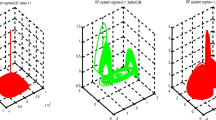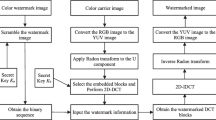Abstract
In recent years, wavelet transform has been widely applied in multimedia signal processing and digital watermarking is involved for ensuring security. This study presents a blind wavelet-based watermarking incorporated with the Human Visual System (HVS), which embeds watermarks into detail-subband coefficients. Since imperceptibility is the most significant issue in watermarking, the approximation band is maintained constant, while the detail subbands are modified to carry information. The perceptual embedded weights for all subbands are determined according to the Just Noticeable Distortion (JND) criterion. The strength of the modification is investigated to provide a balanced result between robustness and image quality. In the decoder, the Least-Mean-Square (LMS) is employed to predict the original detail-subband coefficients and then extract the embedded watermarks. As documented in the experimental results, the proposed method provides good robustness and excellent image quality.











Similar content being viewed by others
References
AI-khassaweneh M, Aviyente S (2006) Spatially adaptive wavelet thresholding for image watermarking. IEEE Int Conf Multimed Expo:1597–1600
Bradley AP (1999) A wavelet visible difference predictor. IEEE Trans Image Process 8(5):717–730
Cox I, Kilian J, Leighton FT, Shamoon T (1997) Secure spread spectrum watermarking for multimedia. IEEE Trans Image Process 6(12):1673–1687
De Christophe C, Delaigle J-F, Macq B (2002) Invisibility and application functionalities in perceptual watermarking – an overview. Proc IEEE 90(1):64–77
Dugad R, Ratakonda K, Ahuja N (1998) A new wavelet-based scheme for watermarking images. IEEE Int Conf Image Process 2:419–423
Guo JM (2007) A new model-based digital halftoning and data hiding designed with LMS optimization. IEEE Trans Multimed 9(4):687–700
Guo JM, Liu YF (2012) High capacity data hiding for error-diffused block truncation coding. IEEE Trans Image Process 21(12):4808–4818
Guo JM, Wu MF, Kang YC (2009) Watermarking in conjugate ordered dither block truncation coding images. Signal Process 89(10):1864–1882
Hsu CT, Wu JL (1999) Hidden digital watermarks in images. IEEE Trans Image Process 8(1):58–68
Huang HC, Pan JS, Huang YH, Wang FH, Huang KC (2007) Progressive watermarking techniques using Genetic algorithms. Circ Syst Signal Process 26(5):671–687
Huang J, Shi YQ, Shi Y (2000) Embedding image watermarks in DC components. IEEE Trans Circ Syst Video Technol 10(6):974–979
Huo F, Guo X (2006) A wavelet based image watermarking scheme. IEEE Int Conf Image Process:2573–2576
Inoue H, Miyazaki A, Yamsmoto A, Katsura T (1998) A digital watermark based on the wavelet transform and its robustness on image compression. IEEE Int Conf Image Process 2:391–395
Khelifi F, Bouridane A, Kurugollu F, Thompson AI (2005) An improved wavelet-based image watermarking technique. IEEE Conf Adv Video Signal Based Surveill:588–592
Li J, Peng H, Pei Z (2007) Adaptive watermarking algorithm using SVR in wavelet domain. IEEE of Int Conf Comput Inf Sci:207–211
Lu CS, Huang SK, Sze CJ, Liao HY (2000) Cocktail watermarking for digital image protection. IEEE Trans Multimed 2(4):209–224
Lu CS, Liao HY (2001) Multipurpose watermarking for image authentication and protection. IEEE Trans Image Process 10(10):1579–1592
Nafornita C, Isar A, Borda M (2005) Image watermarking based on the discrete wavelet transform statistical characteristics. Proc Int Conf Comput Tool 2:943–946
Nikolaidis N, Pitas I (1998) Robust image watermarking in the spatial domain. Signal Process 66(3):385–403
Pan JS, Hsin YC, Huang HC, Huang KC (2004) Robust image watermarking based on multiple description vector quantisation. Electron Lett 40(22):1409–1410
Podilchuk CI, Zeng W (1998) Image-adaptive watermarking using visual models. IEEE J Sel Areas Commun 16(4):525–539
Ratnakar V (1999) Image watermarking with zero-mean patches. Conf Record Thirty-Third Asilomar Conf Signals Syst Comput 2:1513–1517
Shapiro JM (1993) Embedded image coding using zerotrees of wavelet coefficients. IEEE Trans Acoust Speech Signal Process 41(12):3445–3462
Solachidis V, Pitas I (2001) Circularly symmetric watermark embedding in 2-D DFT domain. IEEE Trans Image Process 6(11):1741–1753
Swanson MD, Kobayashi M, Tewfik AH (1998) Multimedia data-embedding and watermarking technologies. Proc IEEE 86(6):1064–1087
van Schyndel RG, Tirkel AZ, Osborne CF (1994) A digital watermark. IEEE Int Conf Image Process 2:86–90
Wang S, Miyauchi R, Unoki M, Kim NS (2015) Tampering detection scheme for speech signals using sormant enhancement based watermarking. J Inf Hiding Multimed Signal Process 6(6):1264–1283
Wang Z, Wang N, Shi B (2006) A novel blind watermarking scheme based on neural network in wavelet domain. Proceeding of the 6th World Congress on Intelligent Control and Automation. 1:3024–3027
Watson AB, Yang GY, Solomon JA, Villasenor J (1997) Visibility of wavelet quantization noise. IEEE Trans Image Process 6(8):1164–1175
Widow B, Hoff ME (1960) Adaptive switching circuits. WESCON Conv Rec 4:96–140
Windrow B, Mccool JM, Larimore MG, Johnson CR (1976) Stationary and nonstationary learning characteristics of the LMS adaptive filter. Proc IEEE 64(8):1151–1162
Yan B, Wang YF, Song LY, Yang HM (2015) Power spectrum compliant QIM watermarking for autoregressive host signals. J Inf Hiding Multimed Signal Process 6(5):882–888
Yen JC, Chen HC, Juan JH (2006) Blind watermarking based on the wavelet transform. Proceeding of Seventh International Conference on Parallel and Distributed Computing. Appl Technol:474–478
Yeung MM, Mintzer F (1997) An invisible watermarking technique for image verification. IEEE Int Conf Image Process 2:680–683
Zhu W, Xiong Z, Zhang YQ (1999) Multiresolution watermarking for images and video. IEEE Trans Circ Syst Video Technol 9(4):545–550
Author information
Authors and Affiliations
Corresponding author
Rights and permissions
About this article
Cite this article
Guo, JM., Liu, YF., Lee, JD. et al. Blind prediction-based wavelet watermarking. Multimed Tools Appl 76, 9803–9828 (2017). https://doi.org/10.1007/s11042-016-3580-2
Received:
Revised:
Accepted:
Published:
Issue Date:
DOI: https://doi.org/10.1007/s11042-016-3580-2




